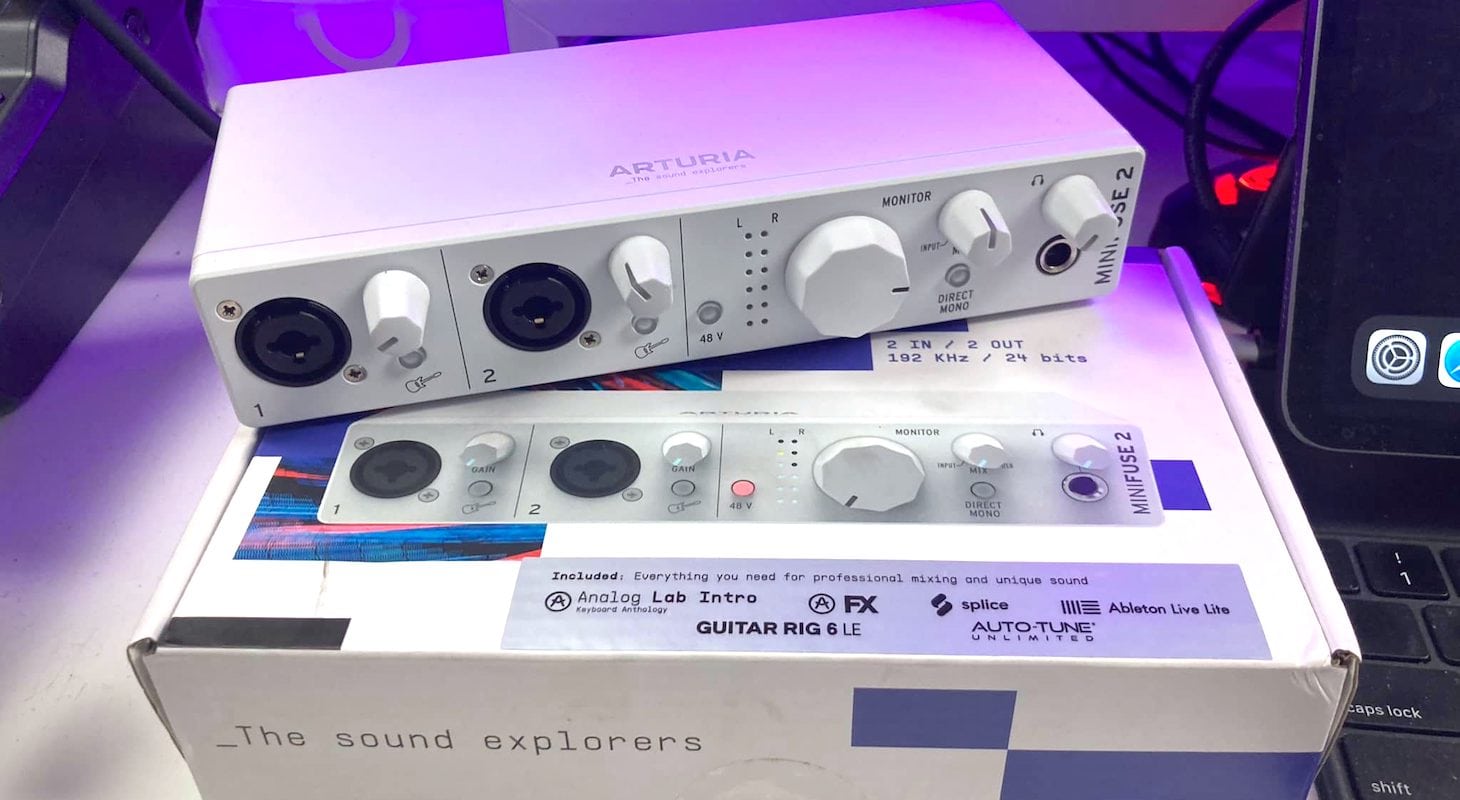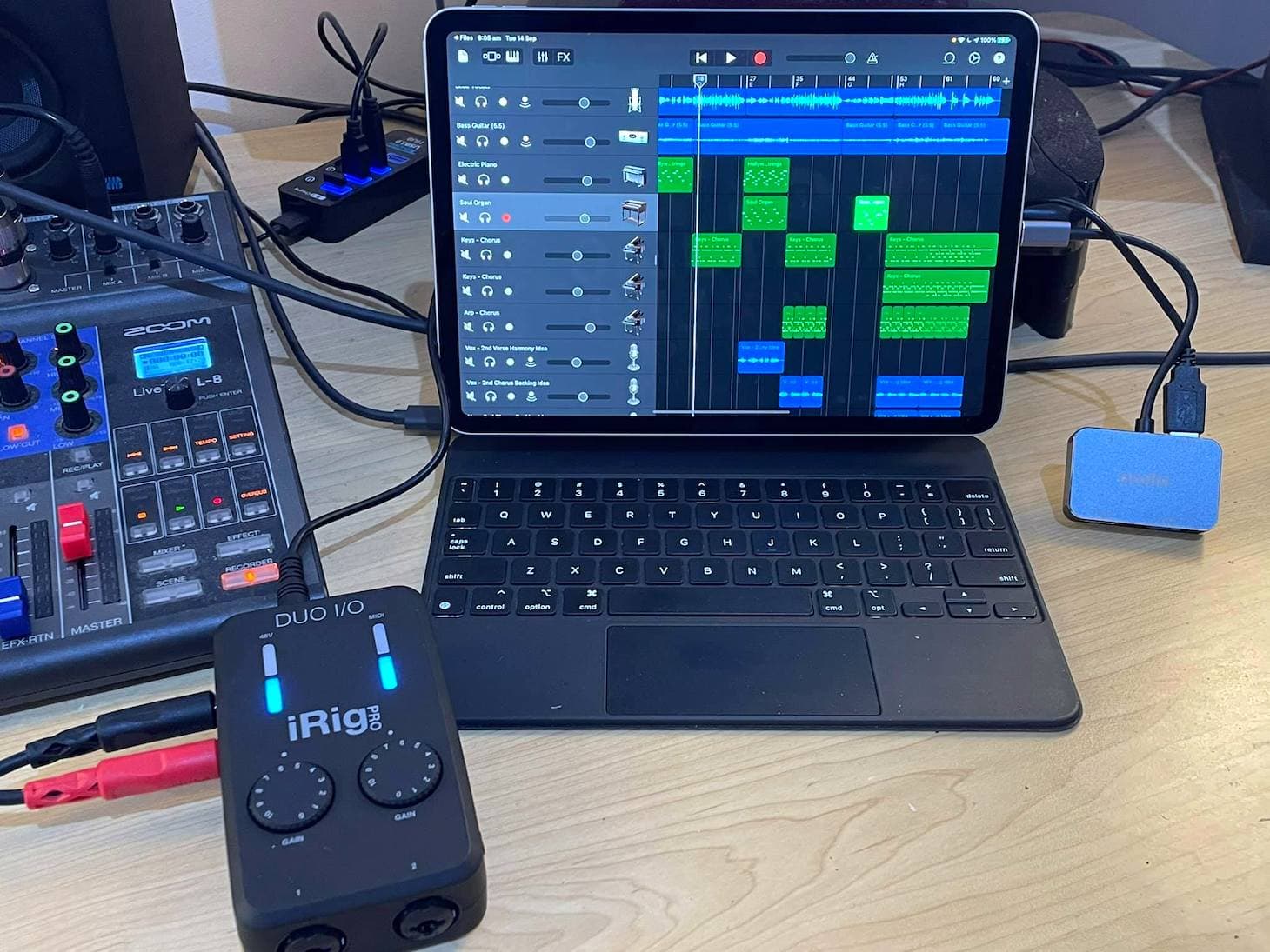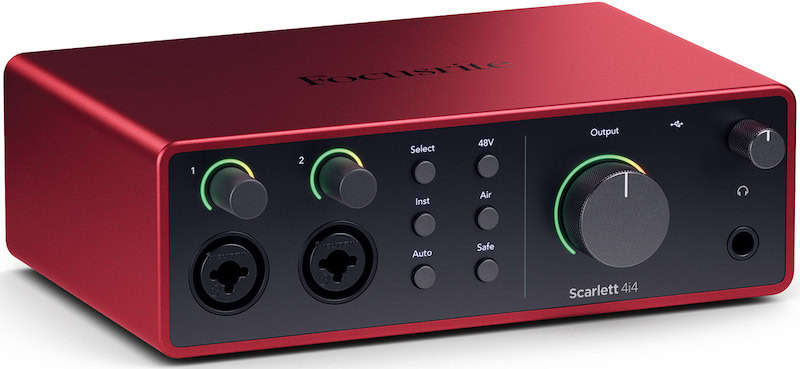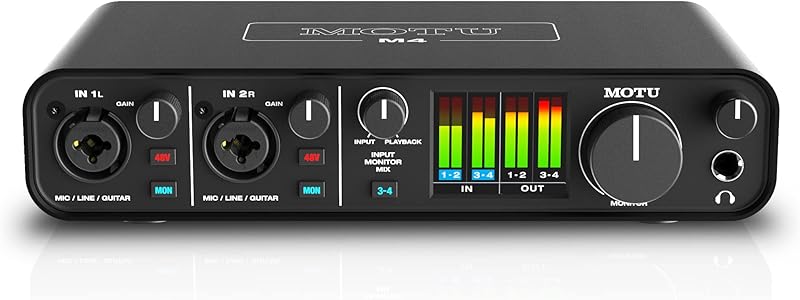Until recently, music production typically required considerable gear. Even modest project studios featured rack hardware, synthesizers, microphones, and multi-input audio interfaces to record it all.
Remember when traveling to other studios meant difficult decisions about what equipment to bring? Those days are over — thanks to iOS devices emerging as effective DAW alternatives.
I'm particularly excited about how iPad-based setups can function as portable versions of your studio.
There's something remarkable about creating music while mobile without carrying a laptop. With iPads now featuring powerful M chips (Apple silicon), so many possibilities have opened up for musicians and producers.
I've recorded with various audio interfaces with my iPad, and I'm eager to share my five favorites with you — they'll enhance your creative process significantly!
5 Best Audio Interfaces for iPad – iOS & Apple-Silicon Friendly!
1. MOTU M4
MOTU began as the company that made the DAW software known as Digital Performer. It was one of the first professional digital audio workstations that could rival the mighty Avid Pro Tools.
The software became quite popular with many producers, especially film composers. After this success, the company went on to develop some seriously high-end and compact audio interfaces.
I bought one of their first interfaces and I've been a loyal fan ever since. What has always set them apart from the competition is their use of top-notch digital converters to capture incredibly detailed, high-definition audio.
I love the sound of the MOTU interfaces because they're fairly neutral yet somehow larger than life without feeling like artificial processing or compression was used to enhance the audio.
Another feature I use a lot — and it might be one of my favorites within the audio industry — is the quality of the preamps on the M4 interface.

MOTU M4
When I was studying engineering, my professor at Berklee College of Music in Boston gave me a very important tip that has really helped me throughout my career: the whole point of having high-definition capture is to record loud. You only use all the bits if you capture your signal nearly at clipping level.
That was very eye-opening for me because I always thought digital audio, being digital, would be clean and pristine no matter what level you recorded it at.
I had assumed analog technology brought in noise when you recorded at low levels and then had to artificially boost in software. But it's even worse with digital because once those ones and zeros of binary code are written, it's very hard to get the full bandwidth back just using plug-ins.
I have tested these preamps with both vintage tube microphones as well as feeding analog synths and drum machines, and I've always been quite impressed with their neutral yet somehow warm characteristics.
Besides the great sound, MOTU has always considered the complete production needs — from running analog gear to podcasting and live streaming. They included inputs and outputs to use with older gear, including a very useful feature that allows you to reroute the master output and re-record through the interface back into your DAW.
For recording, live streaming, and bouncing down on an iOS device, especially the iPad, file management can be tricky since you have to save your bounces either to a USB-C drive or internally into your files or iCloud Drive.
It was always a nightmare for me to locate the right files and keep everything organized in the iOS environment, but with loopback, I can actually record the output to my session and have it muted until I need to check out the different versions. At least I know where my audio is and can quickly reference it.
I also like routing my audio from the master out and bringing it back in through the line inputs 3 and 4.
This allows me to route out to anything, including my pedals, reamping through guitars, or simply applying outboard effects and printing it back into the session.
2. Arturia MiniFuse 2
Arturia knows a thing or two about great analog sound. After all, they're responsible for modeling and recreating the finest collection of virtual instruments emulating all the classic synths and samplers that most of us wish we owned!
They've also ventured into emulating professional studio units like the Space Echo and the Thermionic Culture Vulture.
Impressively, they've put everything they've learned about sound to good use creating the MiniFuse 2.

Arturia MiniFuse 2
As you might expect, this interface doesn't have a sterile, linear sound, but instead offers a deep punch and a natural boost.
It sounds like a digitally controlled analog interface, which I've always loved because I appreciate the reliability and usefulness of digital with the personality and warmth of analog.
This particular unit excels at controlling and outputting VST instruments and recording keyboards and drum machines.
In my setup, I use my iPad with Logic to run different instruments through the interface into my Pro Tools HD system.
I use my mini setup as the main brain of my workstation. Separate from my main session and main audio, it's dedicated to controlling synthesizers, allowing me to play back internal sounds from my iPad.
Why don't I just use it from within my main laptop setup session? That way I wouldn't need two audio interfaces, right?
I do this because I like having the option of taking an audio output from the unit and passing it through compression and EQ.
This approach allows me to capture a really clean instrument path and add color and vibe by routing it through quality circuitry.
If all I did was bounce or record digitally, I wouldn't have the option of running through hardware.
Though this interface is limited in terms of I/O with only two ins and two outs, it also features a loopback system. This allows me to digitally capture my iPad’s output with all my effects and route it back in without losing use of my inputs, which might be recording something else altogether.
It's awesome—a truly professional HD interface that goes up to 192kHz and offers some serious competition to previous models.
Another important use I have for this interface is for content creation. For years now, I've given advice on social media and live-streamed my approach to mixing and producing, as well as some tutorials on sound design.
Many of these sessions I've done remotely, either in hotel rooms or other studios. The cleverly added a blend knob monitoring system to control the dry/wet signal, which allows you to record with very low latency.
Live streaming with low latency and monitoring your live input enables you to perform at your best by eliminating the delay that latency introduces, especially if you're doing anything that needs extremely precise timing like drumming, percussion, or synthesizer and piano performances.
This simple tool allows me to monitor my live input for my best performance while also hearing my audio as it's being recorded to ensure I'm getting the full-bandwidth pristine signal I'm looking for.
It also helps immensely when introducing effects like reverb onto your channel to process after recording your take.
Being able to monitor pre-post is the perfect way to ensure everything is ready so you can focus solely on content creation, whether it's video production or live performance playing.
3. Focusrite Scarlett Solo (4th Generation)
In my opinion, the Focusrite Scarlett series has always been incredibly underrated. Now with the Scarlett Solo (4th generation) out, it's definitely worth comparing against your current top choice.

Focusrite Scarlett Solo Gen 4
Focusrite in general has been an underrated brand. Everyone raves about Neve and SSL as the legendary British sound and emulates their gear, but Focusrite has always been a major player (if not an actual legend) in the pro studio game.
Their high-end ISA line of processors still sells for thousands of dollars, and their discontinued RED series was designed by Beatles' production legend himself, Sir George Martin.
That sonic legacy is being revived in this Scarlett Solo series.
What truly sets this interface apart is the preamps and harmonic drive section. The original Focusrite units used incredible Lundahl transformers to add sweet high-end saturation and compression, giving it a tube-like warmth.
On top of that, the Scarlett Solo includes a fantastic emulation of the ISA original "Air" circuit that boosts higher-end harmonics in a very musical way.
When recording vocals or guitars either at home or in another studio, I always choose the Scarlett because the Harmonic drive alone makes this the most studio-quality front end I've ever heard that works with the iPad.
It also works brilliantly on beats and loops, adding the tiniest bit of compression and soft clipping. This allows you to track at higher levels and utilize the amazing 120dB of headroom the Focusrite boasts.
It's not just the input that's impressive on the Solo — the tone and punch of the analog outputs are equally impressive. I ran several 808 beats through the Scarlett into my spectrum analyzer and found a definite bump in the 60 and 120 Hz range — the sweet spot for punchy kick drums and bass.
This is why this interface has always been a top choice for EDM, pop, and hip-hop producers who travel frequently for recording sessions.
If you're a DJ who also incorporates live instrumentation like hardware synths, Elektron beat boxes, or special pedals into your set, the iPad and Scarlett combo is mind-blowing.
As a part-time DJ myself, I know how limited space can be at most clubs. You're lucky if you can place your laptop in a proper space, let alone a complete laptop/interface setup.
Even when space is too tight for an actual synth, I come prepared with several soft synth combinations in Logic on my iPad, ready to add extra flavor live.
For anything synth or electronic in stereo, the Scarlett is my first choice.
Another major selling point, especially for use in loud environments, is the dedicated headphone amp. It offers the cleanest boost of any in this roundup, and I rarely need to push it beyond 70% volume, even in a loud club.
4. IK Multimedia iRig Pro Duo
I've been a fan of IK Multimedia ever since they released their initial Amplitube guitar amp simulator software. I would pair that with their original iRig and could practice with headphones on my laptop, enjoying any guitar amp sound I dreamed of.
Some of you likely remember that little cylindrical iRig with its single ¼-inch guitar cable input that connected via USB-A to your computer.
They've come a long way since then. The new iRig Pro Duo is more than just a slightly beefed-up version of their first gadget — it's truly professional.
I'm genuinely shocked at how much they've packed into this compact interface.

IK Multimedia iRig Pro Duo connected to iPad Pro.
For starters, I tested the preamps against others and was quite impressed. Including phantom power for condenser mics on a battery-powered device is a significant achievement.
The preamps aren't quite as punchy as the Scarlett ones, but they're extremely quiet and clean. They boast Class A circuitry in their preamps, and I believe them.
One key characteristic of Class A circuitry is its ability to capture lows and highs without hiss or hum. This is especially valuable for guitar tracking, and the iRig excels at recording guitars that need that extra Hi-Z boost.
It's no surprise that the iRig handles guitar tracking so well, given that IK has been at the forefront of amp modeling and effects VSTs, culminating in their award-winning Amplitube 5.
I bought this iRig interface specifically for my Fender Telecaster with vintage humbucker pickups. These pickups sound amazing but require a clean preamp with powerful boost to avoid noise.
I ordered the interface from Sweetwater expecting I'd probably return it, doubting a battery-powered unit would be up to the task. Amazingly, it surpassed my expectations and is definitely a keeper.
I now use it as my main practice and guitar interface, running it through Amplitube 5 and other guitar software on my iPad running Logic.
As a bonus for anyone who doesn't own Amplitube 5, it comes with an LE (lite) version so you can get a taste of the amazing software. The cool thing is it directly transfers any presets you've made if you later decide to upgrade to the full version.
Beyond its guitar capabilities, it also works well for other instruments and vocals. It features full MIDI connectivity and a switch to monitor real-time tracking.
That switch was a bit of a letdown, though.
I prefer the dry/wet mix knob approach of other interfaces that let you smoothly transition and blend between monitoring sources. When you click the iRig's switch while playing, it produces an annoying loud click.This can be particularly irritating when using headphones, forcing you to lower the volume.
That said, for a portable battery-powered unit, this device more than delivers the goods.
5. Apogee Jam X
Lastly, we have the Jam X by Apogee. For any of you who aren't familiar with Apogee, they have been at the forefront of digital converter technology for decades.
Simply put, they make the best digital audio clocks in the world, and their converter circuitry sounds different and better than any other brand. I have tested their digital clocks against all other brands like Avid, Black Lion Audio, Prism, Benchmark, etc. — none of them can match the detail that Apogee inputs capture digitally.
When I heard they had a portable USB-powered mobile interface with their PureDigital patented technology, I ordered one instantly.
Now, a disclaimer: compared to interfaces on this list like the Focusrite, Arturia, and MOTU, this single-preamp, non-battery-powered unit might seem like a downgrade on paper. But don't be fooled — this unit is specifically for audiophiles who truly care about the absolute best sound.
I'm talking about converters used in units costing over $1,000.
That's how good this little device sounds. What makes their PureDigital tech so impressive is their crystal-based zero-jitter clocking. This means when you're capturing signals at 96k, you're truly using a portable HD interface.
I can't think of another portable interface that achieves this level of quality.
Additionally, Apogee is owned by legendary producer and mixing engineer Bob Clearmountain, who has personally helped design, test, and approve their products. That alone is an incredible quality endorsement.
One feature specifically sets this interface apart: its dedicated compression unit with three perfectly tailored auto compression presets designed by the Apogee team, possibly by Clearmountain himself.
The compression is incredibly transparent and musical — not generic. It has a pleasant warmth, and the attack and release times are expertly designed to be foolproof. Even if you know nothing about recording and compression, it's almost impossible to make it sound bad.
It reminds me of the Empirical Labs Fatso, which comes with pre-configured compression curves where you simply dial in the right input and you're set.
This makes it perfect for tracking synths, guitar, and even drum machines. Though you're recording in mono with the drum machine, the sound is glorious. The unit is so good and affordable that I bought two to track in stereo (not on iOS unfortunately). These converters are worthy of being used as a Direct Box on your main system.
It also features zero-latency monitoring — perfect for tracking.
I typically carry this interface when tracking my Moog synths, whether at a recording session or in remote locations like hotel rooms or rehearsal spaces.
For me, tracking analog synths, bass, and guitar demands a great interface.
The Jam comes with an impedance-boosting Hi-Z input circuit that's excellent for guitar but also captures synth bass beautifully. The low end, low mids, and crisp high end are exactly what the PureDigital technology excels at.
It captures larger-than-life presence with astonishing detail. Using two for stereo is worth considering because the converters produce a remarkably wide, rich sound.
Tips for Finding the Perfect IOS Interface
Instruments Specific Recording
This is mostly common sense, but mobile recording is primarily determined by the instrument you play or need to record most.
If you primarily track stereo sources like drum machines and analog synths, then opt for a multi-input interface such as the MOTU, Focusrite, or Arturia. If you mainly want to output the signal of your iPad software or DAW, then I'd recommend the Apogee because its superior clocking and conversion quality delivers a detailed, punchy output for monitoring through larger speakers or for re-recording.
Even the 3.5mm headphone stereo output on the Jam X has pristine circuitry..
Preamp Quality
All of the interfaces on this list have more than adequate, well-defined, professional-level preamps. However, some have higher quality circuitry with more of an analog sound — less linear and more colored, more "vibey."
The Scarlett and iRig provide more of an analog sound, while the Apogee Jam has the most "professional" sounding circuitry — at least for instrument capture. The M4 and MiniFuse excel at clean boost, though they're not particularly sonically interesting.
However, none of these interfaces sound generic, sterile or “cheap”.
For capturing final-take, professional studio-level vocals, I recommend avoiding the more portable, guitar-focused interfaces like the Apogee Jam and iRig. While you could record decent vocals with a dynamic mic, proper condenser mic recording requires a quality phantom-powered preamp.
The larger interfaces, designed to be more versatile and extend beyond iOS, are better suited for tracking vocalists. Fortunately, all these devices offer low-latency tracking, allowing you to record vocals without the distracting latency delay.
Final Thoughts
Ask yourself why you want to use your iPad instead of your laptop as your mobile production setup. This is a difficult question, and I'm often asked about it because I advocate for the smallest possible mobile setup — even using just your iPhone if you can make it work.
Yet I'm something of a contradiction: I'm an audiophile who believes in buying the best equipment you can afford. Do whatever it takes to get the best results for your music. And yet, I love simple mobile setups, as long as they sound good!
The real answer is that using an iPad is more about workflow — it changes HOW you think about producing, which yields new results. By imposing limitations on yourself, you actually enhance creativity.
That's why the interface you choose becomes crucial — it bridges the gap between consumer technology (iPad) and professional capability (Hi-Def 96k recording). So, go small but go mighty.
There's a lot of power in the 5 interfaces above. Happy mobile recording!





